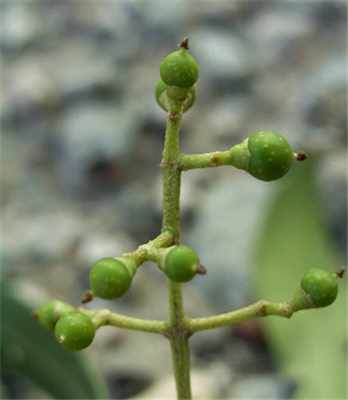Scientific Name
Olea africana Miller
Synonyms
Olea europaea L. subsp. africana (Miller) P.Green
Common Names
wild olive, African olive
Family
Oleaceae
Origin
Wide area from Africa to China
Habit
Perennial, multi-stemmed, evergreen tree which grows to 10m tall. The crown is rounded.
Habitat
Grows well in fertile, well drained soil. Suited to Mediterranean type climates. Found along waterways, in bushland and on rocky hillsides. Chiefly found in coastal districts from Milton north to near Lismore.
General Description
Stems and Leaves:
Leaves are a shiny grey-green colour with the undersurface being green or yellowish brown. Leaves are simple with a rectangular to elliptical shape, entire, with recurved margins. They have a hooked tip and are opposite, growing from 6-10cm long and 10-25mm wide. The petiole (leaf stalk) is 10mm long. The bark is grey to blackish-brown. It is rough but may be smoother in older plants.
Flowers and Fruit:
Small green-cream, privet-like flowers which bloom in late spring to summer. The flowers occur in axillary panicles that are shorter than the leaves. The calyx (the sepals of one flower collectively) is 4 lobed and 1mm long and the corolla (the petals of a flower collectively) is greenish white or cream and is 1-2mm long. The fruit is a round drupe with a sharp tip at the end. The fruit is usually 15-25mm long and 6mm in diameter, fleshy and glaucous (dull blue-green in colour with a whitish bloom which can often be rubbed off). When mature the fruit is black to dark purple. The seed is brown, oblong and is 1 to 1.5cm long and oily.
Distinguishing characteristics
The trees have simple leaves which have a green or yellowish-brown underside. The leaves have a curled tip, depressions or groove between the main vein and secondary veins on the leaf underside are absent. Olea africana may be mistaken for Olea europaea L. subsp. europaea (common olive) that has a grey-green upper surface and an undersurface with a dense covering of silvery, golden or brown scales. The leaves are mostly 3-7cm long and 8-10mm wide without a hooked tip at the apex. Olea africana is not confused with Olea paniculata (native olive) because O. paniculata has slight depressions (domatia) between the main vein and secondary veins on the underside of the leaf; the leaves are ovate to elliptic and usually >2cm wide.
Sources & References
Harden GJ (Ed) (2002) 'Flora of New South Wales.' (University of New South Wales Press Ltd: Sydney, Australia)
Macoboy s (1979) 'What tree is that?.' (Ure Smith: Sydney)
Parsons WT, Cuthbertson EG (2001) 'Noxious weeds of Australia.' 2nd edn. (CSIRO publishing: Collingwood, Victoria)
Australian Government Department of the Environment and Heritage (2004) 'Olea Africana .', www.deh.gov.au
Harding G (1996) 'Sixty indigenous trees of Guateng' www.websight.co.za
Plants of Africa (2002) 'African Olive' www.plantzafrica.com
Prepared by Kylie Pethybridge, 2005
Checked by Carole Campbell, 2005
Updated by Justin KY Chu, July 2005
Checked by Dr Peter Michael, July 2005

